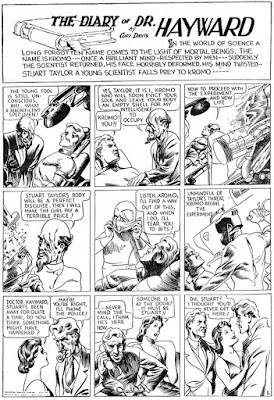1938 Series
Published in English (United States) United States
Publication Dates: September 1938 - March 1953
Number of Issues Published: 167 (#001 - #167)
Color:
Black and White (#1-8); Color (#9 onwards)
Dimensions:
Tabloid:10.5 x 14 1/2 (#1-8); 8.5 x 10.5 inches (#9); Standard Golden Age U.S. (#10 onwards)
Paper Stock: Newsprint
Binding: Saddle-Stitched
Publishing Format: Was ongoing series
Publication Type: magazine
Pages 68 Indicia frequency Monthly
Notes
Original index for this series was created from the indexing work of Henry Steele.
According to Peter Hansen as quoted by Ken Quattro at http://thecomicsdetective.blogspot.com/2010/04/return-to-wonderful-wags-...
the early issues of this comic were direct reprints of the U.K. (and Australian) publication Wags, to which Eisner and Iger had supplied material and bought the printing plates. This is the reason for the unusual (by American standards) size of the early issues.
During the 1920's and 1930's Fiction House produced pulp magazines under imprints such as Real Adventures Publishing Co and Glen-Kel. Late in 1930's Fiction House's owner, Thurman T. Scott, decided to move the company into comic books. The comic market was on the way up and sales of pulp magazines were declining.
In association with Eisner & Iger who were 'packagers', producing comic books on demand issue, #1 of Jumbo Comics was published in September 1938. This would prove, to be at least in the short term, a shrewd business move by Thurman Scott.
In the first issue and making her American debut was 'Sheena, Queen of the Jungle' a character that Will Eisner and S.M. 'Jerry' Iger had previously created for a British magazine titled Wags. The leggy and scantily clad Sheena would became a mainstay of the company's stable. She also would set the tone of many of the subsequent titles which would feature 'Good Girl Art'.
With Jumbo's popularity Fiction House would then publish such titles as: Jungle Comics, Wings Comics, Firehair and Eisner's The Spirit. It would now be a major comic book producer for the next 15 years.
From http://furycomics.com


Authors:
Script
Bob Kane, S. M. Iger, Donald DeConn, Will Eisner, Audrey Blum,
Dick Briefer,Tom Alexander, Lee Harris
Pencils,
Bob Kane, S. M. Iger, Donald DeConn, Jack Kirby, Will Eisner, Mort Meskin,
Bernard Baily, Rafael Astarita, Nina Albright,
Lee Harris, Robert Webb, Alex Blum, Dick Briefer,
Inks
Bob Kane, S. M. Iger, Donald DeConn, Jack Kirby, Will Eisner, Mort Meskin,
Bernard Baily, Rafael Astarita, Nina Albright
Lee Harris, Ann Brewster, Dick Briefer
Colors
?
Letters
Jack Kirby
Sheena, Queen of the Jungle

Sheena, Queen of the Jungle is a fictional American comic book jungle girl heroine, originally published primarily by Fiction House. She was the first female comic book character with her own title, with her 1937 (in Great Britain; 1938 in the United States) premiere preceding Wonder Woman #1 (cover-dated Dec. 1941). Sheena inspired a wealth of similar comic book jungle queens. She was predated in literature by Rima, the Jungle Girl, introduced in the 1904 William Henry Hudson novel Green Mansions.
An orphan who grew up in the jungle, learning how to survive and thrive there, she possesses the ability to communicate with wild animals and is proficient in fighting with knives, spears, bows, and makeshift weapons. Her adventures mostly involve encounters with slave traders, white hunters, native Africans, and wild animals.
Fiction House
Sheena debuted in Joshua B. Power's British magazine Wags #1 in January 1937.She was created by S. M. "Jerry" Iger who ran his own small studio, "Universal Phoenix Features" (UFP), and who commissioned Mort Meskin to produce prototype drawings of Sheena. UFP was one of a handful of studios that produced comics on demand for publishers and syndicates, and whose client Editors Press Service distributed the feature to Wags. Saying he could no longer afford to pay Will Eisner as a freelancer, he co-founded Eisner & Iger, which continued the work of UFP, but Iger bought out Eisner when (according to Iger) Eisner went to produce propaganda for the US Army but other sources say Eisner left so he could create The Spirit. To help hide the fact their studio consisted only of themselves, the duo signed their Sheena strip with the pseudonym "W. Morgan Thomas". Eisner said an inspiration for the character's name was H. Rider Haggard's 1886 jungle-goddess novel She.
Sheena first appeared stateside in Fiction House's Jumbo Comics #1, and subsequently in every issue (Sept. 1938 – April 1953), as well as in her groundbreaking 18-issue spin-off, Sheena, Queen of the Jungle (Spring 1942 – Winter 1952), the first comic book to title-star a female character.Sheena also appeared in Fiction House's Ka'a'nga #16 (Summer 1952) and the one-shot 3-D Sheena, Jungle Queen (1953)—the latter reprinted by Eclipse Comics as Sheena 3-D (January 1985) and by Blackthorne Publishing as Sheena 3-D Special (May 1985). Blackthorne also published Jerry Iger's Classic Sheena (April 1985).
From Wikipedia, the free encyclopedia
LINKS: Jumbo Comics (#001 - #167)⇲⇲

















No comments:
Post a Comment